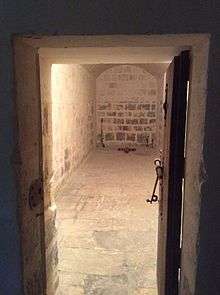Dry cell (prison)

In prison terminology a dry cell is a room that prisoners are placed in that lacks any plumbing facilities such as a toilet or shower. In the Federal Bureau of Prisons, a dry cell can be used if a prisoner claims to be unable to urinate for a drug test under direct visual supervision.[1] Prisoners are also sometimes placed in dry cells if they are suspected of having swallowed contraband. The idea is that they will eventually excrete all the contents of their digestive system, and lacking any toilet, they will be unable to dispose of it and thereby prevent prison officials from acquiring the evidence.[2]
References
- ↑ Federal Bureau of Prisons (8 March 2001). "PS 6060.08, Urine Surveillance and Narcotic Identification" (PDF).
Staff may consider supervising indirectly an inmate who claims to be willing but unable to provide a urine sample under direct visual supervision. For example, this might be accomplished by allowing the inmate to provide the sample in a secure, dry room after a thorough search has been made of both the inmate and the room.
- ↑ Oregon Department of Corrections (15 October 2005). "Dry Cell Status" (PDF).
Dry Cell Status: A visual monitoring process which, after reasonable suspicion has been established, allows for the placement of an inmate in a cell for the safe recovery of internally concealed instruments and other contraband.
This article is issued from Wikipedia - version of the 9/21/2016. The text is available under the Creative Commons Attribution/Share Alike but additional terms may apply for the media files.